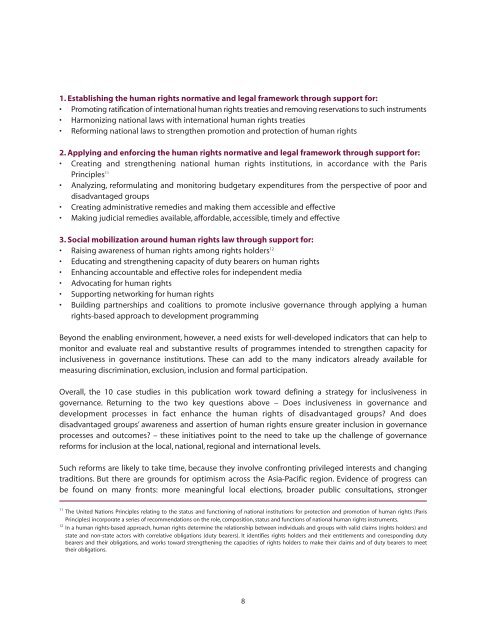View / Download - HRBA Portal
View / Download - HRBA Portal
View / Download - HRBA Portal
You also want an ePaper? Increase the reach of your titles
YUMPU automatically turns print PDFs into web optimized ePapers that Google loves.
1. Establishing the human rights normative and legal framework through support for:• Promoting ratification of international human rights treaties and removing reservations to such instruments• Harmonizing national laws with international human rights treaties• Reforming national laws to strengthen promotion and protection of human rights2. Applying and enforcing the human rights normative and legal framework through support for:• Creating and strengthening national human rights institutions, in accordance with the ParisPrinciples 11• Analyzing, reformulating and monitoring budgetary expenditures from the perspective of poor anddisadvantaged groups• Creating administrative remedies and making them accessible and effective• Making judicial remedies available, affordable, accessible, timely and effective3. Social mobilization around human rights law through support for:• Raising awareness of human rights among rights holders 12• Educating and strengthening capacity of duty bearers on human rights• Enhancing accountable and effective roles for independent media• Advocating for human rights• Supporting networking for human rights• Building partnerships and coalitions to promote inclusive governance through applying a humanrights-based approach to development programmingBeyond the enabling environment, however, a need exists for well-developed indicators that can help tomonitor and evaluate real and substantive results of programmes intended to strengthen capacity forinclusiveness in governance institutions. These can add to the many indicators already available formeasuring discrimination, exclusion, inclusion and formal participation.Overall, the 10 case studies in this publication work toward defining a strategy for inclusiveness ingovernance. Returning to the two key questions above – Does inclusiveness in governance anddevelopment processes in fact enhance the human rights of disadvantaged groups? And doesdisadvantaged groups’ awareness and assertion of human rights ensure greater inclusion in governanceprocesses and outcomes? – these initiatives point to the need to take up the challenge of governancereforms for inclusion at the local, national, regional and international levels.Such reforms are likely to take time, because they involve confronting privileged interests and changingtraditions. But there are grounds for optimism across the Asia-Pacific region. Evidence of progress canbe found on many fronts: more meaningful local elections, broader public consultations, stronger11 The United Nations Principles relating to the status and functioning of national institutions for protection and promotion of human rights (ParisPrinciples) incorporate a series of recommendations on the role, composition, status and functions of national human rights instruments.12 In a human rights-based approach, human rights determine the relationship between individuals and groups with valid claims (rights holders) andstate and non-state actors with correlative obligations (duty bearers). It identifies rights holders and their entitlements and corresponding dutybearers and their obligations, and works toward strengthening the capacities of rights holders to make their claims and of duty bearers to meettheir obligations.8



